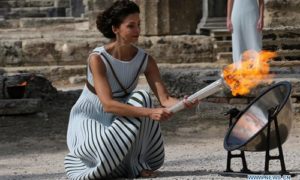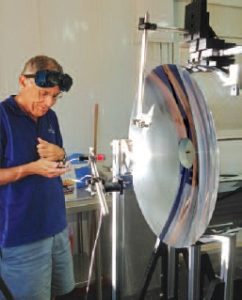
The Power of the Parabolic Mirror
February 12, 2018
Alternative Energy, Desert & Water Research
Smithsonian.com — After 101 days of traveling by plane, train, automobile, Korean warship, zipline, and even robot, the Olympic torch finally reached the site of the Winter Games in Pyeong Chang, South Korea. At the opening ceremony, South Korean figure skater Yuna Kim used it to light the Olympic cauldron in a grand, symbolic start to the games.
While the blaze looks like any other, its origins are special. It was lit not with matches or a Zippo lighter, but with a parabolic mirror, echoing rituals from Ancient Greece.

To brush up on algebra, a parabola is a type of arc that is defined by the exact curvature of its sides. Revolve a parabola around its axis, and you have the shape of a parabolic mirror. Unlike most curves, which scatter incoming light in many directions, the reflected beams bounce from a parabola and all concentrate to one point, the focus.
These reflective surfaces are used in a number of devices to concentrate not only reflected light, but also sound or radio waves. Satellite dishes, some types of microphones, reflecting telescopes, and even car headlights benefit from the reflective properties of parabolic dishes.

Prof. Jeffrey Gordon in his lab with his powerful parabolic mirror
In the case of the Olympics, when the sun shines on a parabolic dish, known to the ancient Greeks as a skaphia or crucible, the rays all bounce off its sides and collect at one blazing hot point. Put a piece of paper—or a gas torch—in that focal point, and you get fire.
A lone parabolic dish does a decent job heating things up, achieving temperatures of at least hundreds of degrees. “That’s really very easy to reach,” says Prof. Jeffrey Gordon of the Alexandre Yersin Department of Solar Energy and Environmental Physics at BGU’s Jacob Blaustein Institutes for Desert Research.
But, of course, conditions are never ideal. First, some of that heat is lost to the atmosphere. Then, some is absorbed into your reflective surface, and still another fraction is scattered away due to imperfections in the mirror.
“The parabola is a good concentrator but not a perfect concentrator,” Prof. Gordon adds.
Prof. Gordon’s research is focused on pushing the limits of sun concentration to the max. Using multiple concentrating mirrors, his lab has achieved temperatures of nearly 3,000 degrees Celsius (roughly 5,400 degrees Fahrenheit), applying the heat for a range of feats, including a sun-powered surgical laser and a reactor for creating nanomaterials.
But now, at some truly blistering temps, he has a different problem. “We start to destroy everything,” he says.
As for Olympic torch lighting, the issues are somewhat more mundane. For one, there’s the potential for clouds. In the days leading up to the modern torch lighting ceremony at the ancient temple of Hera in Olympia, the organizers lit a flame in a parabolic dish, just in case clouds obscured the sun on the day of the ceremony. The preparedness proved useful at this year’s event, which took place on a drizzly morning.
Along the lines of Prof. Gordon’s research, people have practiced the concentration of the sun’s rays for thousands of years. The most famous example of solar concentration comes from 212 B.C.E. during the siege of Syracuse, Greece. The Greek mathematician and inventor Archimedes used the parabolic mirror, so the story goes, to deter a fleet of approaching ships, crafting a solar death ray using panels of what was likely polished bronze.



